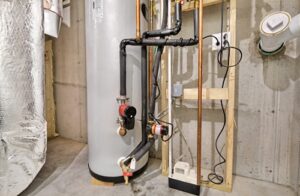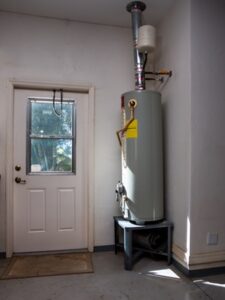As a homeowner, few things are more disheartening than turning on the tap, eagerly anticipating a warm shower, only to be met with an unexpected rush of icy water. Most people in this situation will be asking, why is my hot water heater no longer working?
If your once-reliable residential hot water heater has left you shivering in disbelief, you’re not alone. The discomfort of a malfunctioning water heater can disrupt daily routines and leave homeowners searching for answers, especially during the colder months of the year.
In this article, we delve into the intricacies of why your residential hot water heater may no longer be producing the comforting warmth you’ve come to rely on.
From pilot light woes to electric heating element malfunctions, we explore the common culprits that can plunge your home into a chilling dilemma. Join us on a journey through the potential reasons behind your water heater’s cold rebellion, and discover the steps you can take to restore the soothing embrace of hot water to your daily life.
The Age of a Water Heater Matters a Great Deal
The age of a water heater can significantly impact its ability to produce warm water efficiently in a home. As these appliances age, various components may deteriorate or experience wear and tear, leading to diminished performance. Here’s how the age of a water heater can affect its functionality.
Sediment Buildup:
Over time, sediment, minerals, and debris can accumulate at the bottom of the water heater tank. This sedimentation can insulate the heating element from the water, reducing its efficiency and making it harder for the water heater to produce and maintain hot water temperatures.
Corrosion:
Corrosion is a natural process that affects metal components, including the tank itself. As the water heater ages, corrosion can weaken the tank’s integrity, leading to the development of leaks. Leaks not only result in water wastage but can also compromise the heating element’s ability to function properly.
Deteriorating Heating Elements:
In electric water heaters, the heating elements can degrade over time due to constant exposure to high temperatures. As these elements wear out, they become less effective at heating the water, resulting in a decrease in the overall temperature of the delivered hot water.
Thermostat Inaccuracy:
The thermostat is responsible for regulating the water temperature inside the tank. With age, thermostats may become less accurate or fail to maintain the desired temperature settings. This can lead to water that is either too hot or not hot enough, affecting the overall comfort and efficiency of the water heater.
Energy Efficiency Decline:
Older water heaters may lack the energy efficiency features found in newer models. Modern water heaters are designed to meet higher efficiency standards, utilizing advanced insulation and technology to conserve energy. Aging water heaters tend to operate less efficiently, resulting in increased energy consumption and higher utility bills.
Obsolete Technology:
Technological advancements in water heater design and efficiency may leave older models outdated. Newer water heaters often incorporate features such as smart controls, improved insulation, and faster heating mechanisms, providing better performance and cost savings.
While routine maintenance can extend the lifespan of a water heater, it’s essential to consider replacement options as the unit ages. Upgrading to a newer, more energy-efficient model not only ensures reliable hot water but can also lead to long-term cost savings and reduced environmental impact. If your water heater is approaching its typical lifespan of 10-15 years, it may be prudent to explore modern alternatives to maintain optimal comfort and efficiency in your home.
Different Parts of a Water Heater That Can Break and Cause Cold Water
If your water heater is no longer producing hot water, it may be due to various broken or malfunctioning parts within the unit. Identifying these issues is crucial for effective troubleshooting and timely repairs. Here are some common broken parts that can lead to a water heater failing to produce hot water.
Faulty Heating Element:
In electric water heaters, the heating element is responsible for warming the water. A broken or burned-out heating element can result in insufficient or no hot water production. Replacing the faulty heating element is often necessary to restore normal operation.
Damaged Thermocouple:
A gas water heater relies on a thermocouple to regulate the gas flow to the burner. If the thermocouple is damaged or malfunctioning, it may prevent the gas valve from opening, leading to a lack of heat. Replacing a faulty thermocouple is a common repair to address this issue.
Malfunctioning Gas Control Valve:
The gas control valve is responsible for regulating the flow of gas to the burner. If this valve is broken or malfunctioning, it can disrupt the ignition process and hinder the water heating process. A professional technician may need to replace the gas control valve.
Corroded Anode Rod:
The anode rod is a sacrificial component that helps prevent corrosion within the water heater tank. If the anode rod becomes corroded itself, it may no longer effectively protect the tank, leading to corrosion and leaks. Replacing the anode rod during routine maintenance can prevent this issue.
Leaking Tank:
Over time, the tank itself may develop leaks due to corrosion or other issues. A leaking tank can result in a loss of hot water and potential water damage. Unfortunately, if the tank is damaged, replacement is usually the only viable solution
Broken Dip Tube:
The dip tube directs incoming cold water to the bottom of the tank for heating. If it breaks or becomes dislodged, cold water may mix with the hot water near the top, leading to a reduction in overall water temperature. Replacing the dip tube is necessary in such cases.
Failed Pressure Relief Valve:
The pressure relief valve is a safety feature designed to release excess pressure from the tank. If it fails, the tank may experience excessive pressure, potentially resulting in a loss of hot water and posing a safety risk. Replacing a faulty pressure relief valve is crucial.
When dealing with broken parts in a water heater, it’s important to exercise caution and, if necessary, seek professional assistance. Gas-powered water heaters, in particular, involve potential safety hazards, and repairs may require the expertise of a qualified technician. Regular maintenance and prompt repairs can help extend the lifespan of your water heater and ensure a reliable supply of hot water in your home.
Also Consider Home Demand When Trying to Troubleshoot a Faulty Water Heater
Water demand can indeed play a significant role in the perception that no warm water is being produced by a water heater. Understanding how water demand affects the heating system can help homeowners troubleshoot and address this issue. Here are some key factors to consider.
High Hot Water Demand:
If multiple hot water fixtures or appliances are in use simultaneously, such as showers, dishwashers, and washing machines, the demand for hot water can exceed the heater’s capacity to supply it. This may lead to a temporary reduction in water temperature, making it seem as though the water heater is not producing sufficient warm water.
Tank Size and Recovery Rate:
The size of the water heater tank is a crucial factor in meeting hot water demand. Smaller tanks may deplete their hot water supply quickly, especially during periods of high demand. Additionally, the recovery rate, which is the speed at which the water heater can reheat the incoming water, can impact its ability to keep up with demand.
Inadequate Water Heater Capacity:
If the water heater’s capacity does not align with the household’s hot water needs, it may struggle to meet demand during peak usage times. Consider upgrading to a larger capacity water heater if your current one is consistently unable to provide enough hot water.
Temperature Setting and Mixing Valve Issues:
Check the thermostat setting on the water heater to ensure it is appropriately adjusted. If the temperature is set too low, the water may not reach the desired warmth. Additionally, issues with mixing valves, which blend hot and cold water, can affect the overall water temperature.
Water Heater Maintenance:
Sediment buildup in the water heater tank can reduce its efficiency and hinder its ability to meet hot water demand. Regular maintenance, such as flushing the tank to remove sediment, can optimize performance and ensure a consistent supply of warm water.
Flow Rate Restrictions:
Low water pressure or flow rate can impact the delivery of hot water to fixtures. Check for any restrictions in the water lines, filters, or pressure regulators that may impede the flow of hot water.
Cross-Connection Issues:
Cross-connections occur when cold water mixes with the hot water supply. This can happen if there are faulty check valves or other issues in the plumbing system. A professional plumber can identify and correct cross-connection problems.
Smart Water Management:
Consider implementing smart water management practices, such as staggering the use of hot water appliances or using low-flow fixtures. This can help distribute hot water more evenly and prevent overwhelming the water heater during peak demand periods.
By considering these factors and making adjustments to accommodate household water demand, homeowners can enhance the efficiency of their water heaters and ensure a consistent supply of warm water. If issues persist, or if there are concerns about the water heater’s performance, it’s advisable to consult with a professional plumber or technician for a thorough inspection and appropriate solutions.
In conclusion, the sudden absence of hot water from your residential heater can be a frustrating and inconvenient experience, disrupting the comfort and routine of daily life. This article has explored various reasons behind this predicament, ranging from common issues like pilot light problems, faulty heating elements, and sediment buildup to more intricate concerns such as thermostat malfunctions and aging components.
Understanding the potential culprits behind a water heater’s reluctance to produce hot water is the first step toward a solution. Regular maintenance, proactive troubleshooting, and timely repairs can significantly extend the lifespan and efficiency of your water heater. Moreover, recognizing the impact of water demand, whether due to simultaneous usage or inadequate heater capacity, emphasizes the importance of aligning your system with the needs of your household.
As you navigate the complexities of your water heating system, remember that safety is paramount. When in doubt or faced with challenges beyond your expertise, seeking the assistance of a qualified professional is always advisable. With proper care and attention, your residential hot water heater can continue to provide the warmth and convenience essential to your daily life for years to come.
